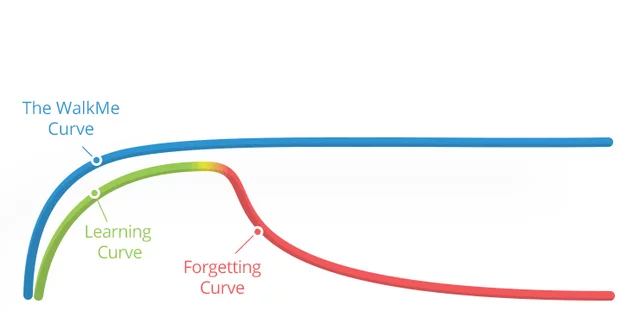Effective employee software training is critical in any modern office, whether onboarding one new employee or implementing a platform for thousands. Understanding how to effectively train people in a variety of digital tools has become a challenge for enterprise organizations.
The Digital Adoption Platform (DAP) is a new digital tool that addresses many of the shortcomings of traditional software training. Wondering if it could be a fit for your company?
Here are five telltale signs that your employee software training strategy needs a DAP.

Instantly make employee software training simple by using WalkMe’s DAP.
Table of Contents
hide
1. Your employees use multiple, niche software systems
Stop me if this sounds familiar: You have Salesforce for CRM, Kronos for HR, Sharepoint for file sharing, Asana for project management — and that is just to name a few. Each department distributes their workflow in a way that makes sense for them, adopting additional specialized platforms. A new hire receives relevant training and expected to master multiple software platforms, each of which has a different look and feel. The average employee will get comfortable performing their daily tasks, but will not reach for expertise. Here is the catch — not all software is used routinely. In fact, an employee might receive instructions in October on how to submit a vacation request, but it isn’t until May that he actually asks for time off. At this point, his memory has been wiped clean and he needs a second round of instructions. This might not sound like such a big deal, but vacation forms are only the tip of the iceberg — it can happen with any number of tasks that simply aren’t performed often enough to stick. Ultimately this results in slowed processes and additional time and resources spent reteaching an employee something that they were supposed to already know. With a Digital Adoption Platform in place, employees can refer back to real-time training sessions on-demand. A DAP guides employees through complex tasks on any platform, playing the role of both the trainer and the friendly colleague who steps in when confusion or forgetfulness hits.2. Training sessions don’t occur as often as software updates
Let’s say your onboarding system is impeccable — each employee is imparted with a toolbox of technical skills ensuring their success. For the sake of argument, let’s agree that these employees have perfect memories and never forget their training. However, thanks to the wonders of cloud-based applications, your software rolls out automatic updates. Updates are great: new features, improved functions and more efficient ways of working — that is, if your employees know how to take advantage of them. Often updates intended to improve workflow end up being ignored, or worse, sending well-adjusted users back into confusion. Supplementary training would help remedy the situation, of course, but if you conducted training sessions every time one of your platform got an upgrade, no work would ever get done. For organizations using WalkMe’s DAP, help is only a click away. In addition, the DAP will also detect if there is a better way to perform any given task drawing from newest features to cut time and effort.
3. Your current software training and onboarding program is expensive
The expense of software learning programs is a major pain point. Software training is necessary, but that doesn’t mean you should be overpaying for a system that is not providing results. Consider the average salary of a training and onboarding professional, the various eLearning tools such as webinars and knowledge bases, not to mention the time trainees are spending away from their desks. All these expenses add up quickly.Utilize WalkMe’s real-time guidance to ensure software onboarding is smooth and simple.
With WalkMe’s DAP, all your training expenses are rolled into one neat little package available to every employee from their desktop. Additionally, training does not take them away from their task, rather guides them through it in real time.4. You aren’t getting a positive ROI on your software investment
It is impossible to discuss the price of software training without injecting a line or two about the cost of the software itself. Software vendors sell subscriptions based on huge promises of driving revenue while saving time and resources. Organizations then allocate significant budgets to these cutting-edge digital platforms in order to capitalize on the benefits of streamlined operations and heightened employee productivity. The problem is not that there is anything inherently wrong with the software, but like any powerful tool, employees must know how to use it. Full adoption is necessary to see a positive return on investment. A company that realizes this will stand to benefit greatly from a DAP. Why? First, it can be layered on absolutely any software program. That means it backs the investment you already made, making it unnecessary to start switching users from one system to the next. Second, it guarantees your employees not only reach competency, but always make the most out of software. Third, it is cheaper than traditional training.5. Your organization is working towards digital maturity
If you are a business in the digital age, it is almost a given that some capacity of your organization is the midst digital transformation. While technology should not be a focal point of digital strategy, an increasing number of software platforms is an inherent symptom of the transition. The number of work applications in use will only rise as digitization becomes the norm. Whether it is onboarding one new employee or an entire organization, a Digital Adoption Platform paves the way for smooth and successful digital adoption.Easily digitize your business with WalkMe’s step-by-step guidance. Try it today for free.

